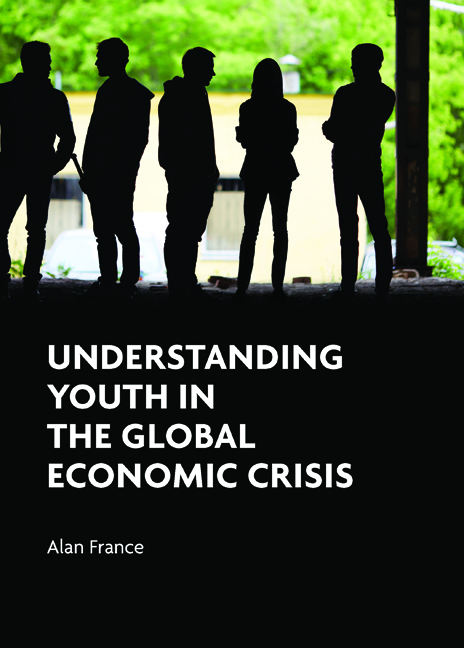Book contents
- Frontmatter
- Dedication
- Contents
- List of tables and figures
- About the author
- Acknowledgements
- Introduction
- One A political ecology of youth
- Two The global crisis and the ‘age of austerity’
- Three Education and training: the broken promise
- Four Education and training: from public good to private responsibility
- Five Unemployment and work: precarious futures
- Six NEETs and the disengaged: the ‘new’ youth problem
- Seven Divergence and difference: contrasting cross-national experiences of being young
- Eight Education, work and welfare in diverse settings
- Nine Youth and mobility: inequality, leaving home and the question of youth migration
- Ten After the crisis: social change and what it means to be young
- References
- Index
One - A political ecology of youth
Published online by Cambridge University Press: 01 September 2022
- Frontmatter
- Dedication
- Contents
- List of tables and figures
- About the author
- Acknowledgements
- Introduction
- One A political ecology of youth
- Two The global crisis and the ‘age of austerity’
- Three Education and training: the broken promise
- Four Education and training: from public good to private responsibility
- Five Unemployment and work: precarious futures
- Six NEETs and the disengaged: the ‘new’ youth problem
- Seven Divergence and difference: contrasting cross-national experiences of being young
- Eight Education, work and welfare in diverse settings
- Nine Youth and mobility: inequality, leaving home and the question of youth migration
- Ten After the crisis: social change and what it means to be young
- References
- Index
Summary
Introduction
The process of ‘growing up’ or ‘becoming adult’ is highly complex and is shaped and influenced by ideas, relationships and events in the local and national context (Heinz, 2009). Growing up is therefore experienced differently in different environments and settings. However, as will become clear in the discussions that follow in this book, there are similar patterns and outcomes that can create a collective experience of growing up, even across national boundaries. Making sense of how social context constructs and defines what it means to be young, especially in periods of social change, is important and has long been a central feature of the study of youth (White and Wyn, 2008; Jones, 2009a; MacDonald, 2011; Furlong, 2013). While the history of youth sociology is not straightforward, its theoretical development has shadowed that of sociology in general. However, the ability of existing approaches to make sense of the contemporary worlds of the young has been increasingly challenged by the limits of these models. Therefore I believe an approach that draws on broader sociological and other social science approaches is needed. In the first part of this chapter we will explore recent developments in youth sociology, highlighting a number of key debates and challenges that, despite producing important knowledge, have left us with gaps in our understanding about the structuring of young people's social, cultural and economic lives. In the second part of the chapter I will develop an alternative way of making sense of and conceptualising the social context of young people's lives, introducing a political ecological approach that aims to provide a framework for the rest of the book. In the third section the discussion will focus on the ecological role of ‘policy,’ showing how it has a critical role to play in structuring young people's experiences at a number of levels. It finishes with an exploration of how youth policy is formed, emphasising the forces and processes that underpin its construction.
Theorising youth
Theorising of youth in sociology has a long history, linked to the Chicago School and other early American critical sociologists in the 1930s and 1940s (France, 2007). Some of the most influential works in the modern era came from the American functionalist theorists Parsons (1942) and Eisenstadt (1956).
- Type
- Chapter
- Information
- Understanding Youth in the Global Economic Crisis , pp. 13 - 36Publisher: Bristol University PressPrint publication year: 2016

